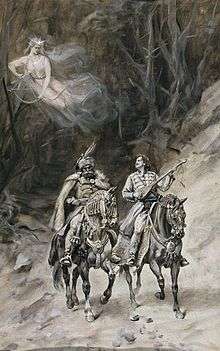Vila (fairy)
Vila (plural: vile) is a South Slavic fairy similar to a nymph, female, beautiful and with long blonde hair. Serbo-Croatian: vila, Slovene: vila, Bulgarian: vila, diva, juda, samovila, samodiva, samojuda, Old East Slavic: vila, Slovak: víla.[1]

The vila is known among South Slavs and Slovaks only, quotations about her occurrence among Poles are wrong. Among Czechs, vila denotes a wood spirit (15th century), and ancient place names such as Vilice near Tábor, Vilov near Domažlice, and Vilín near Sedlčany seem to indicate that she was known there as well. In the Chronicle of Dalimil (3, 53) vila is "fool" (as in Old Polish). Czech: víla appears to be a loanword from South Slavic, because of the vocal length. In Russia, vile are mentioned in the 11th century, but there is doubt that they were truly a part of Russian folklore, and not just a literary tradition. There are common traits between the vile and the rusalki, and Schneeweis holds that they are identical.
The etymology is unclear. Possible explanations are from the verb viti "to wind" and Church Slavonic: vichъrь "whirlwind"; or from Sanskrit: vāyú- "air", Proto-Indo-European u̯ēi̯o- "wind".
Among South Slavs, vile are portrayed as beautiful women with long blonde hair. There are three kinds, those living on land and in forests (Serbo-Croatian: zagorkinje, pozemne vile), water nymphs (Serbo-Croatian: brodarice, povodne vile), and cloud or air nymphs (Serbo-Croatian: vile oblakinje, zračne vile). They appear as swans, falcons, horses, or wolves; cloud nymphs appear as a whirlwind. At night, they roam the clouds emitting a terrible noise of pipes and drums. Anyone who calls them becomes stiff and moves only with difficulty. He is stricken by disease and dies within a year or two.
Vile like to ride horses or stags, they go hunting (a parallel to the goddess Diana), dance in a circle dance (Serbo-Croatian: vilino kolo, Bulgarian: samodivski igriška) and seek the love of handsome strong men, assisting them against their enemies. Their fondness for fighting is reminiscent of the teutonic Valkyrie and is unique in Slavic mythology. They possess supernatural powers and are able in the art of healing. They build splendid castles at the edges of clouds. They confuse men's spirits with their arrows. They steal children and substitute them with changelings. In Slovakia, vile are the restless souls of deceased girls who lure young men into a deadly circle dance.
In Serbian epic poetry, every hero has a vila as an elective or blood sister (Serbo-Croatian: posestrima). The best known is Serbo-Croatian: Ravijojla, a name probably derived from Raphael. Girls can also have vile as blood sisters, and may ask them to improve one's beauty or to protect a distant lover.
Vile are usually friendly to people, but they can take horrible revenge on those who insult them, disregard their orders, or uninvitedly approach their circle dance. Their general amiability distinguishes them from the rusalki. The folk venerated them by placing flowers, food and drink before caves where they were believed to have lived.
Western European references
TMeyer's Konversationslexikon defines Wiles or Wilis as female vampires, the spirits of betrothed girls who die before their wedding night. According to Heine, wilis are unable to rest in their graves because they could not satisfy their passion for dancing naked, especially in town squares. They also gather on the highway at midnight to lure young men and dance them to their death. In Serbia, they were maidens cursed by God; in Bulgaria, they were known as samodiva, girls who died before they were baptized; and in Poland, they are beautiful young girls floating in the air atoning for frivolous past lives. In some tales, the reason for abandoning their loves is a sad one. The Vila are cursed never to find their true love. If they do, that love will die a terrible death.
This legend inspired Victor Hugo to include "les wilis" in his poem "Fantômes" in Les Orientales (1828).
Heinrich Heine in his 1835 De l'Allemagne vividly describes "die Wilis" as a Slavic legend.
The wilis appear in Adolphe Adam's Romantic ballet Giselle, first danced in Paris in 1841, as the ghosts of young girls who were betrayed by their lovers and who died before their wedding days. They dance in the forests on moonlit nights, punishing young men by dancing them to death, but must disappear at the break of dawn. These Wilis snatch away the villainous Hilarion's life-breath, and almost do the same for the hero, Albrecht, but he is saved by the love of the ghostly Giselle.
The first opera completed by Giacomo Puccini, Le Villi, makes free use of the same thematic material. It had its debut in May 1884 at the Teatro Dal Verme, Milan, and was revised for a more successful reception at the Royal Theater, Turin, that December.
In The Vilia Song (German: Das Vilja-Lied), from the 1905 operetta The Merry Widow (German: Die lustige Witwe) by Franz Lehár, Viktor Léon and Leo Stein (and translated by Adrian Ross), a hunter pines for Vilia, "the witch of the wood," a fairy being who causes him to fall in love with her and then vanishes.
Loosely Englished as "the willies," these ghostly Vilis gave rise to the idiom, "to give someone the willies," i.e., "to create a feeling of nervousness, fear, or creepiness in someone."
In J.K. Rowling's Harry Potter series, veela are magical beings who resemble stunningly beautiful women. They can put men into trance with their singing and dancing, and when angered, they transform into horrific, bird-like creatures and can launch fireballs from their hands. Veela appear in fourth book of the series, Harry Potter and the Goblet of Fire, where they serve as mascots to the Bulgarian Quidditch team during the Quidditch World Cup. The character Fleur Delacour is also a quarter-veela. [2]
References
- Norbert Reiter (1973), "Mythologie der alten Slaven", in Hans Wilhelm Haussig (ed.), Wörterbuch der Mythologie, 2, pp. 163–208
- Colbert, David. The Magical Worlds of Harry Potter. ISBN 0-9708442-0-4.